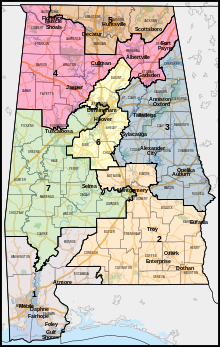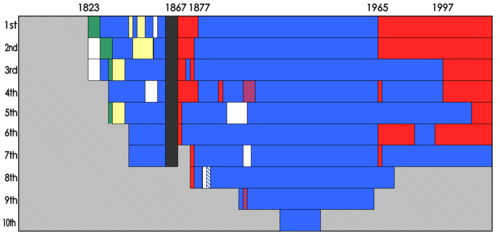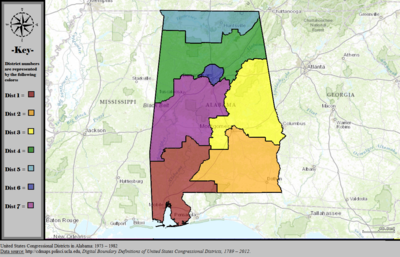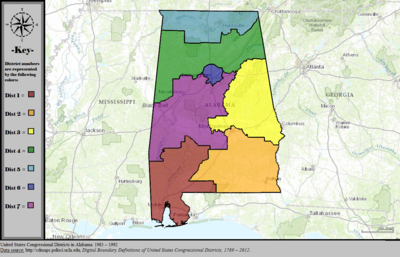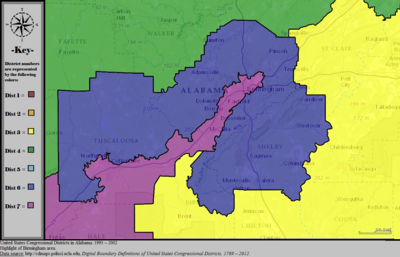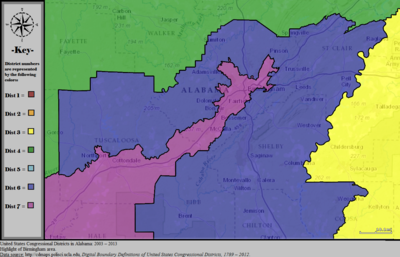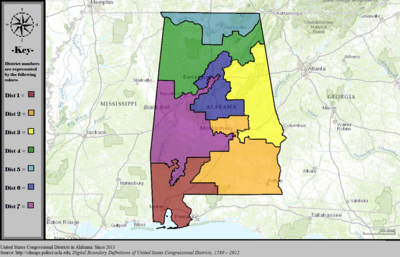
North Carolina is currently divided into 14 congressional districts, each represented by a member of the United States House of Representatives. After the 2000 census, the number of North Carolina's seats was increased from 12 to 13 due to the state's increase in population. In the 2022 elections, per the 2020 United States census, North Carolina gained one new congressional seat for a total of 14.

The 2003 Texas redistricting was a controversial intercensus state plan that defined new congressional districts. In the 2004 elections, this redistricting supported the Republicans taking a majority of Texas's federal House seats for the first time since Reconstruction. Democrats in both houses of the Texas Legislature staged walkouts, unsuccessfully trying to prevent the changes. Opponents challenged the plan in three suits, combined when the case went to the United States Supreme Court in League of United Latin American Citizens v. Perry (2006).
Alabama's 7th congressional district is a United States congressional district in Alabama that elects a representative to the United States House of Representatives. The district encompasses Choctaw, Dallas, Greene, Hale, Lowndes, Marengo, Pickens, Perry, Sumter and Wilcox counties, and portions of Clarke, Jefferson, Montgomery and Tuscaloosa counties. The district encompasses portions of the Birmingham, Montgomery and Tuscaloosa/Northport urban areas. The largest city entirely within the district is Selma.

South Carolina's 1st congressional district is a coastal congressional district in South Carolina, represented by Republican Nancy Mace since January 3, 2021. She succeeded Democrat Joe Cunningham, having defeated him in the 2020 election. Cunningham was the first Democrat to represent the district since the 1980s.

Florida's 5th congressional district is a congressional district in the U.S. state of Florida. It includes the southeastern area of Jacksonville which comprises areas such as Arlington, East Arlington, Southside, Mandarin, San Jose, and the Beaches. It stretches south to St. Augustine in St. Johns County.

Florida's 3rd congressional district is an electoral district of the United States House of Representatives located in Florida. It presently comprises a large section of north central Florida, including the entire counties of Alachua, Baker, Bradford, Columbia, Dixie Gilchrist, Hamilton, Levy, Suwannee, and Union, along with the majority of Lafayette and Marion County. The city of Gainesville is in the district as well as part of Ocala.

Virginia is currently divided into 11 congressional districts, each represented by a member of the United States House of Representatives. The death of Rep. Donald McEachin on November 28, 2022, left the 4th congressional district seat empty. Following the results of a special election to fill his seat on February 21, 2023, Jennifer McClellan made history by becoming Virginia's first black congresswoman.
Vieth v. Jubelirer, 541 U.S. 267 (2004), was a United States Supreme Court ruling that was significant in the area of partisan redistricting and political gerrymandering. The court, in a plurality opinion by Justice Antonin Scalia and joined by Chief Justice William Rehnquist and Justices Sandra Day O'Connor and Clarence Thomas, with Justice Anthony Kennedy concurring in the judgment, upheld the ruling of the District Court in favor of the appellees that the alleged political gerrymandering was not unconstitutional. Subsequent to the ruling, partisan bias in redistricting increased dramatically in the 2010 redistricting round.

Redistricting in Pennsylvania refers to the decennial process of redrawing state legislative and federal congressional districts in Pennsylvania.
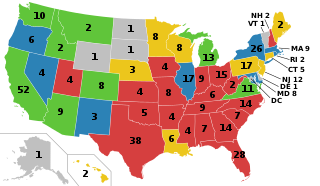
Gerrymandering is the practice of setting boundaries of electoral districts to favor specific political interests within legislative bodies, often resulting in districts with convoluted, winding boundaries rather than compact areas. The term "gerrymandering" was coined after a review of Massachusetts's redistricting maps of 1812 set by Governor Elbridge Gerry noted that one of the districts looked like a mythical salamander.
The National Democratic Redistricting Committee (NDRC) is a US political organization that focuses on redistricting and is aligned with the Democratic Party. It was founded in 2017 with the primary goal of stopping partisan gerrymandering and advocating for fair and transparent redistricting processes. The organization coordinates campaign strategy, supports redistricting reform, and files lawsuits against state redistricting maps.

The 2020 United States redistricting cycle is in progress following the completion of the 2020 United States census. In all fifty states, various bodies are re-drawing state legislative districts. States that are apportioned more than one seat in the United States House of Representatives are also drawing new districts for that legislative body.
REDMAP is a project of the Republican State Leadership Committee of the United States to increase Republican control of congressional seats as well as state legislatures, largely through determination of electoral district boundaries. The project has made effective use of partisan gerrymandering, by relying on previously unavailable mapping software such as Maptitude to improve the precision with which district lines are strategically drawn. The strategy was focused on swing blue states like Pennsylvania, Ohio, Michigan, North Carolina, and Wisconsin where there was a Democratic majority but which they could swing towards Republican with appropriate redistricting. The project was launched in 2010 and estimated to have cost the Republican party around US$30 million.

Redistricting in Wisconsin is the process by which boundaries are redrawn for municipal wards, Wisconsin State Assembly districts, Wisconsin State Senate districts, and Wisconsin's congressional districts. Redistricting typically occurs—as in other U.S. states—once every decade, usually in the year after the decennial United States census. According to the Wisconsin Constitution, redistricting in Wisconsin follows the regular legislative process, it must be passed by both houses of the Wisconsin Legislature and signed by the Governor of Wisconsin—unless the Legislature has sufficient votes to override a gubernatorial veto. Due to political gridlock, however, it has become common for Wisconsin redistricting to be conducted by courts. The 1982, 1992, and 2002 legislative maps were each enacted by panels of United States federal judges; the 1964 and 2022 maps were enacted by the Wisconsin Supreme Court.
Allen v. Milligan, 599 U. S. 1 (2023), is a United States Supreme Court case related to redistricting under the Voting Rights Act of 1965 (VRA). The appellees and respondants argued that Alabama's congressional districts discriminated against African-American voters. The Court ruled 5–4 that Alabama’s districts likely violated the VRA, maintained an injunction that required Alabama to create an additional majority-minority district.
Smiley v. Holm, 285 U.S. 355 (1932), was a decision of the Supreme Court of the United States involving a governor's power to veto a congressional redistricting proposal passed by a state's legislature. In an opinion by Chief Justice Charles Evans Hughes, the Court unanimously held that the U.S. Constitution did not prohibit Minnesota's governor from vetoing that state's redistricting map.

The 2024 United States House of Representatives elections will be held on November 5, 2024, as part of the 2024 United States elections, to elect representatives from all 435 congressional districts across each of the 50 U.S. states, as well as six non-voting delegates from the District of Columbia and the inhabited U.S. territories. Special elections may also be held on various dates throughout 2024. Numerous other federal, state, and local elections, including the U.S. presidential election and elections to the Senate, will also be held on this date. The winners of this election will serve in the 119th United States Congress, with seats apportioned among the states based on the 2020 United States census.

The 2024 United States House of Representatives elections in Louisiana will be held on November 5, 2024, to elect the six U.S. representatives from the state of Louisiana, one from each of the state's congressional districts. The elections will coincide with the U.S. presidential election, as well as other elections to the House of Representatives, elections to the United States Senate, and various state and local elections.
Redistricting in Alabama is the process by which boundaries are redrawn for federal congressional and state legislative districts. It has historically been highly controversial. Critics have accused legislators of attempting to protect themselves from competition by gerrymandering districts.
Alexander v. South Carolina State Conference of the NAACP is a pending United States Supreme Court case regarding racial gerrymandering and partisan gerrymandering. It's the first partisan gerrymandering case taken by the Supreme Court after its landmark decision in Rucho v. Common Cause which stated that partisan gerrymandering claims present political questions beyond the reach of the federal courts, and the first racial gerrymandering case after the court's landmark decision in Allen v. Milligan.
